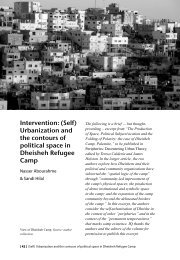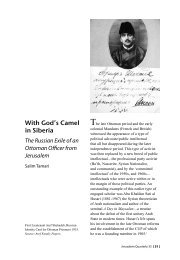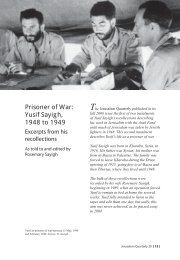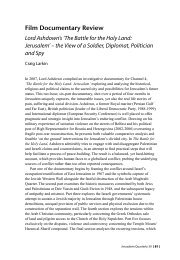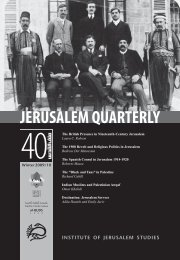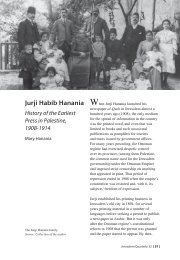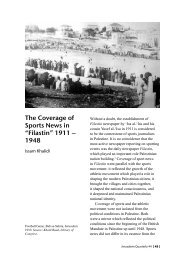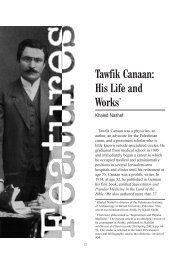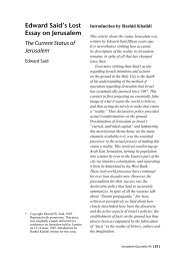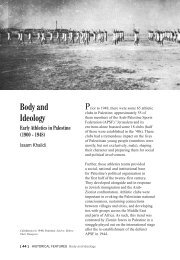PLUNDERING PALESTINE - Jerusalem Quarterly
PLUNDERING PALESTINE - Jerusalem Quarterly
PLUNDERING PALESTINE - Jerusalem Quarterly
Create successful ePaper yourself
Turn your PDF publications into a flip-book with our unique Google optimized e-Paper software.
UN observers did draw some conclusions in October, writing to the<br />
Secretary General–who did not publish their report–that Israeli policy was<br />
that of ‘uprooting Arabs from their native villages in Palestine by force<br />
or threat.’ Arab member states attempted to bring the report on Palestine<br />
to the attention of the Security Council, but to no avail. For almost thirty<br />
years, the UN uncritically adopted the rhetorical obfuscations of Abba<br />
Eban, Israel’s ambassador to the UN, who referred to the refugees as<br />
constituting a ‘humane problem’ for which no one could be held accountable<br />
or responsible. (p. 190)<br />
Pappe also brings to life for the reader Palestinian villages that were destroyed in<br />
1948, evoking their architecture, landscape and social life. Travelling on the road<br />
from <strong>Jerusalem</strong> to Tel Aviv after reading Pappe’s book, I saw the whole country as<br />
though it were wearing new attire. A foreign presence has come and shorn the hills and<br />
coastal plains of century-old villages, terraced land and orchards, replacing them with<br />
new dwellings differently planned, built and coloured. This presence then cultivated<br />
the hills with pine trees that covered the ruins, turning them from what had been into<br />
how the colonizer thought it should be. I found myself looking at the Israeli towns<br />
nestled between pine forests with new eyes. Born after 1948, I have no memory of the<br />
ancient villages that graced these hills before they were destroyed by Zionist forces<br />
during and after 1948. For the first time, I was lamenting the loss of those beautiful<br />
spots and seeing the new Israeli towns as I do the settlements in the West Bank:<br />
artificial implants by a colonizing state.<br />
One of the merits of the book is its powerful impact on readers, who see what is<br />
familiar in a new and revealing light. Another important aspect of the book is that it<br />
focuses not only on the destruction, but describes the ancient villages with a real sense<br />
of loss. It is proof of the extent to which the author, an Israeli Jew, is liberated from<br />
bias that he is capable of lamenting the loss of what is purely Palestinian.<br />
Some would say that this book produces outrage and anger at the injustice perpetrated<br />
earlier by the Jewish forces and more recently by Israel’s army, and that the book<br />
could incite extremism, thus offering ammunition to those who call for the destruction<br />
of the Jewish state.<br />
But this is not the message of the book or the purpose of the author. Pappe’s book is a<br />
desperate appeal for both sides, Israeli Jews and Palestinians, and for the international<br />
community to come to terms with the past. He writes:<br />
Neither Palestinians nor Jews will be saved, from one another or from<br />
themselves, if the ideology that still drives the Israeli policy towards the<br />
Palestinians is not correctly identified. The problem with Israel was never its<br />
<strong>Jerusalem</strong> <strong>Quarterly</strong> 33 [ 69 ]



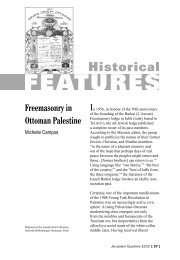
![In Search of Jerusalem Airport [pdf] - Jerusalem Quarterly](https://img.yumpu.com/49007736/1/180x260/in-search-of-jerusalem-airport-pdf-jerusalem-quarterly.jpg?quality=85)
